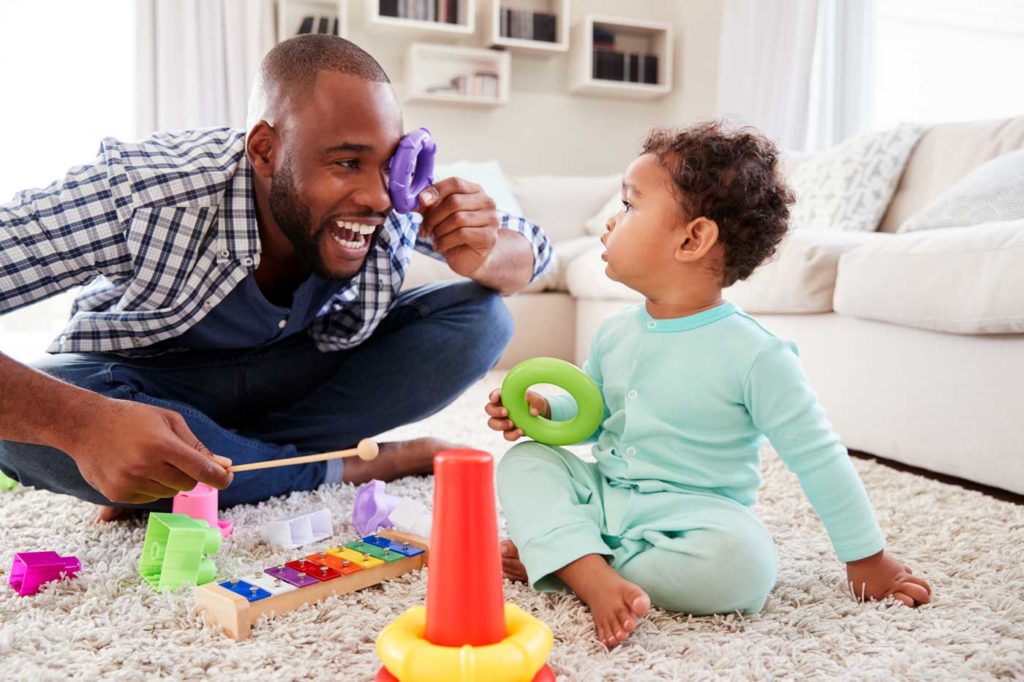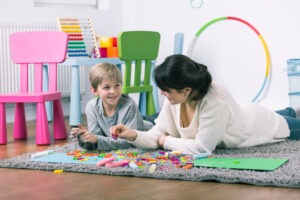You hear a sound in the sky and point as you say, “look, an airplane!”, expecting your child to gaze upwards. While rolling a ball back and forth, you wait for your child to look at the ball, then at you, to show you he or she wants you to pass it back. After covering your eyes, you stand by for your child to pull your hands down with a big smile as you say, “Peek a boo!”.
These are all examples of joint attention – an important set of skills for children to develop.
Showing joint attention is a critical step within a child’s social and language development. Typically, children start showing joint attention skills as early as 6 to 9 months old. They do things like look towards a stuffed animal that their parents are looking at or focus on pictures in a book while sitting with a family member.
For children on the Autism Spectrum, joint attention skills are often delayed. In fact, a lack of eye contact and sharing experiences with others can be one of the first recognized signs of Autism. Let’s talk more about what joint attention is, why it’s so important, and some tips to develop these skills with children on the Autism Spectrum!
What is Joint Attention & Why is it so important?
Simply put, joint attention is the act of making eye contact with someone as you share an experience.
When children do this (even before they are able to talk), they learn some very important skills. For example, the value of communicating with others, taking turns, and the meaning of emotions shown by different facial expressions. Children also learn to take another person’s point of view (known as theory of mind).
Research has proven that joint attention skills in young children are correlated with more advanced spoken language and higher social skills as children grow.
Why do Children with Autism have difficulty using Joint Attention?
A lack of joint attention is known as a “core deficit” for children on the Autism Spectrum. Doing things like looking at a toy that you point to or coming up to you and tickling you to show he or she wants to start a back and forth game can be difficult for kids with Autism. That’s because they often lack the social skills needed to share experiences like these. In order for children with Autism to communicate their wants and needs (and socialize with others by saying “hi”, making comments, and responding to what someone says), establishing joint attention is crucial!
Tips for Improving Joint Attention Skills
#1: Be a good language model.
A great way to encourage your child to use joint attention skills is by modeling them yourself!
Talk to your child often and comment on things around you. Use gestures like pointing as you talk. For example, point to a block as you say “block” while building with your child. Look upward and point, saying “bird!” when you hear a bird while taking a walk with your child. Try taking your child’s finger and helping him or her point as you name different pictures in a book for him or her to find.
#2: Get on your child’s level.
Lay on the floor, get eye level at your child’s little table by sitting on your knees, hold toys by your face as you play! Positioning yourself at your child’s level makes it easier for him or her to shift their attention between objects and you. And that can encourage your child to make more eye contact.
#3: Follow your child’s lead.
Instead of trying to start a new activity, observe what your child is doing as he or she interacts with toys. Ask yourself – what toys or activities seem to capture your child’s attention the best? What does he or she like to do with them? Consider starting by playing near your child with the same kind of toy and in a similar way as him or her. For example, if he or she is pushing a toy train, grab your own train and push it back and forth while laying on the floor next to your child. Slowly join in play with him or her by putting your train on the same tracks as your child or encouraging a “race” where you push your trains at the same time after you say “ready, set, go!”.
#4: Imitate your child.
One of the best ways to capture your child’s interest and boost their enjoyment in an activity is by imitating them! If he or she is throwing a ball up in the air, get another ball and copy your child. If your child makes an “ooo” sound every time after knocking down a tower of blocks, build your own tower and do the same. Not only is your child likely to think it’s fun to watch you imitate them, but this can also lead to you and your child taking turns!
#5: Play!
Keep it fun! Try playing games with one another that allow your child to have fun without even using any toys. Some examples? Hold your child’s hands and swing them every time they reach upwards. Give your child a piggyback ride, pause, and turn around. When he or she looks at you, keep going! If your child likes to move, try starting a game of chase. The more fun your child has, the more likely he or she is to show joint attention with you!
If you are concerned with your child’s joint attention skills or speech and language development, a Speech-Language Pathologist (also known as a “Speech Therapist”) can conduct an evaluation to assess these areas. The therapist will provide recommendations, which might include your child attending regular speech therapy to improve their skills. TherapyWorks is a company that provides Speech, Occupational, Feeding, and Physical Therapy Services via teletherapy across the US and in-home in Illinois, Ohio, and Michigan.








